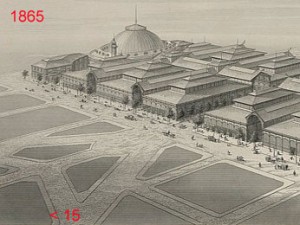And Florent gazed at the vast markets now gradually emerging from the gloom, from the dreamland in which he had beheld them, stretching out their ranges of open palaces. Greenish-grey in hue, they looked more solid now, and even more colossal with their prodigious masting of columns upholding an endless expanse of roofs. They rose up in geometrically shaped masses; and when all the inner lights had been extinguished and the square uniform buildings were steeped in the rising dawn, they seemed typical of some gigantic modern machine, some engine, some caldron for the supply of a whole people, some colossal belly, bolted and riveted, built up of wood and glass and iron, and endowed with all the elegance and power of some mechanical motive appliance working there with flaring furnaces, and wild, bewildering revolutions of wheels.1
Emile Zola’s 1873 novel The Fat and the Thin (or The Belly of Paris) deals with the social world of the Les Halles markets, just after they were rebuilt in the 1850s. It tells the story of a gentle and ineffectual revolutionary, Florent Quenu, who makes a clandestine return from penal exile on Devil’s Island, French Guyana, to discover a transformed Paris. Despite his native ‘thinness’ – indicative of his hunger and idealistic character – he becomes embroiled in the visceral and down to earth world of the new markets, only to eventually fall foul of the law again; undone by local gossip, the acquisitive, small-mindedness of his petit bourgeois family, and his own, relatively harmless, predilection for subversive plotting. The pathos and bathos of the story, as well as the general thematic conflict between craven, bloated complacency and principled hunger, is closely related to the market setting. Indeed the setting figures less as a passive background to the human drama than as a dominant narrative force. The descriptive passages extend well beyond the immediate needs of the relatively lightly developed dramatic action. They position the market itself, in all its rich complexity, in all its variety of smells, colours and textures, as the main protagonist and focus of interest.
I am interested in this apparently excessive effort at description. It indicates, if nothing else, Zola’s intimate knowledge of Les Halles. Much of the writing resembles a painter’s plein air sketch of specific places. It is very evidently the work of a highly observant flaneur. Zola seems to write less from a distanced space of recollection than one of immediate observation and note-taking. Despite the fictional central story, the markets themselves are described in a closely-detailed, documentary fashion (in the manner in which the so-called “city symphony” documentaries of the 1920s and 1930s portray the distinctive life of Berlin, Paris or Moscow).
Closely allied to this documentary spirit, a compellingly modern feature is Zola’s interest in the near cosmological scale and emerging social implications of the new Parisian markets. The massive steel and glass superstructure encloses a complex and highly differentiated field of hyperbolic material existence and market-based social relations. Over half a century prior to Walter Benjamin’s The Arcades Project, Zola presents a sophisticated meditation on fundamental currents of change within European society linked to the growth of market capitalism. Especially interesting is the curious balance that is maintained between the human and inhuman dimensions of this transformation. The markets are still peopled. They produce distinct, representative characters – characters that can take an active place within a narrative. There is little sense of the anonymous throng, or mass-produced produce or alienated consumption. For example, the central character, Florent, despite his inclination, cannot disappear, cannot meld into an indistinguishable urban crowd. He is obsessively observed by the spiteful gossip, Mademoiselle Saget. Not a detail of his current life or past history can pass unnoticed. At one level this may seem to signal new regimes of urban surveillance, but at another level it links back to traditional forms of village life, in which everybody is known, in which anonymity is not permitted. Zola’s portrait of Les Halles seems to indicate a point of social simultaneity, when aspects of the old (material-craft based production and identity, visceral capitalism and local social relations) come to be housed within a new superstructural frame (the steel and glass edifice of Les Halles, the emerging universe of consumption).
- Zola, E. 2006 The Fat and the Thin (translated by Ernest Alfred Vizetelly), Project Gutenberg, www.gutenberg.org/ ↩

